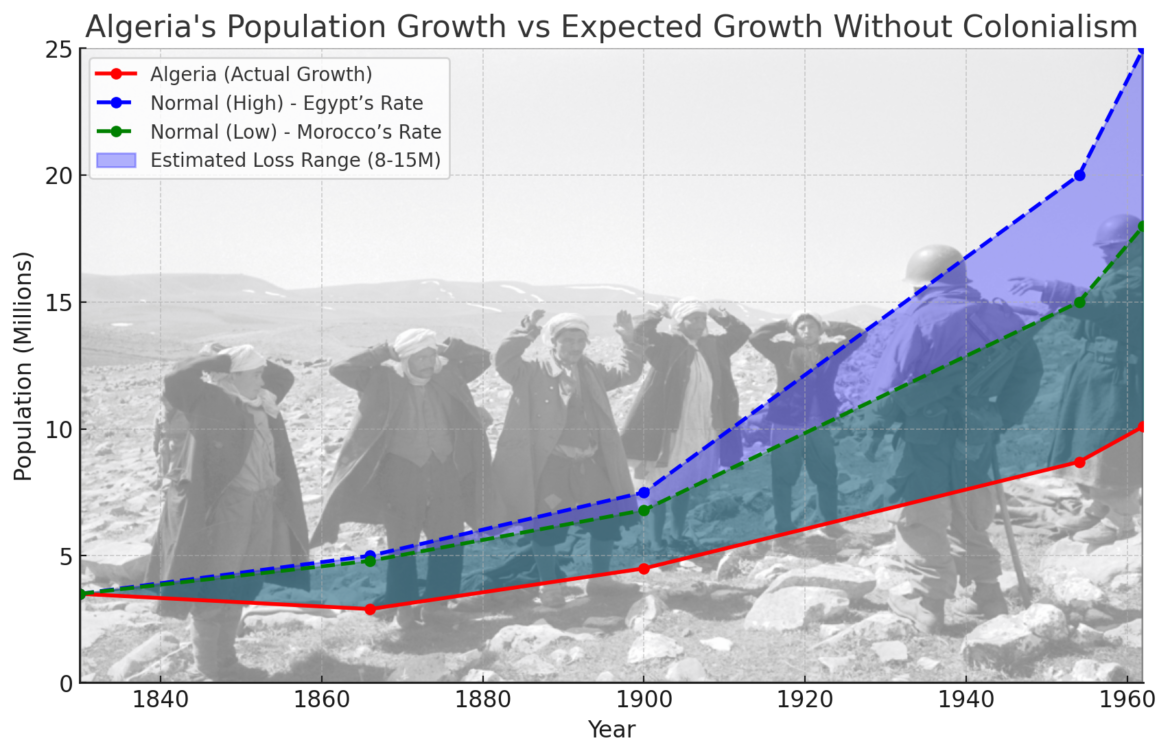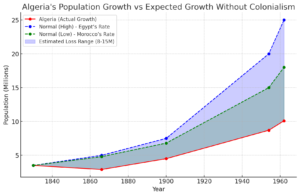Introduction
From 1830 to 1962, Algeria experienced one of the most brutal and transformative colonial occupations in modern history under French rule. While global populations surged during this period due to industrialization, medical advancements, and agricultural innovation, Algeria’s demographic trajectory starkly diverged. This article analyzes Algeria’s population data from 1830 to 1962, revealing how systemic colonial violence, economic exploitation, and social disruption suppressed growth to rates far below global and regional norms.
Pre-Colonial Baseline (Pre-1830)
Before French invasion in 1830, Algeria’s population is estimated at 3–4 million, based on Ottoman records and European traveler accounts (Kateb, 2001). The region was part of the Ottoman Empire, with a largely agrarian economy and tribal social structures.
Colonial Period (1830–1962): Phases of Suppressed Growth
France’s 132-year occupation of Algeria can be divided into phases marked by conquest, settlement, and repression. Population growth was stifled by deliberate policies and systemic neglect.
1. Conquest and Mass Death (1830–1870s)
- French military campaigns: The initial conquest (1830–1847) and subsequent anti-resistance operations (e.g., Emir Abdelkader’s rebellion) caused 500,000–1 million Algerian deaths through warfare, massacres, and scorched-earth tactics (Horne, 1977).
- Displacement: Tribes were forcibly relocated to arid regions, disrupting food production.
- 1866–1868 Famine: French land confiscation and taxation policies triggered a catastrophic famine, killing 500,000–800,000 Algerians (15–20% of the population) (Ageron, 1991).
2. Settler Colonialism and Economic Exploitation (1870s–1945)
- Land theft: By 1900, French settlers (colons) controlled 40% of Algeria’s arable land, displacing subsistence farmers (Kateb, 2001).
- Healthcare apartheid: Europeans received modern medical care, while Algerians faced epidemics (cholera, typhus) and infant mortality rates of 30–40% (Clio-Infra, n.d.).
- Labor exploitation: Forced labor in mines, farms, and infrastructure projects suppressed birth rates and increased mortality (Fanon, 1961).
3. World Wars and Final Colonial Crisis (1945–1962)
- World War II: Over 200,000 Algerians were conscripted; postwar famines and unemployment worsened living conditions (UN Demographic Yearbooks).
- Algerian War of Independence (1954–1962): French counterinsurgency tactics (e.g., mass internment, torture, and village destruction) killed 300,000–1 million Algerians and displaced 2 million (Horne, 1977).
Population Data and Growth Rates
| Year | Estimated Population (Millions) | Notes |
|---|---|---|
| 1830 | 3.5 | Pre-colonial baseline (Kateb, 2001). |
| 1866 | 2.9 | Post-famine collapse (Ageron, 1991). |
| 1900 | 4.5 | Slow recovery under settler economy (Clio-Infra, n.d.). |
| 1954 | 8.7 | Pre-war census (BnF Gallica Archives). |
| 1962 | 10.1 | Post-independence estimate (UN Demographic Yearbooks). |
Annual Growth Rate Analysis
- 1830–1962: ~0.8% annually (total growth: ~3x).
- Global average (19th–20th century): ~1.0–1.2% annually (Clio-Infra, n.d.).
- Neighboring Comparisons:
- Egypt: 1.3% annually (1830: 4 million → 1960: 26 million) (McCarthy, 1990).
- Morocco: 1.1% annually (1830: 3 million → 1960: 12 million) (Weeks, 2015).
Algeria’s growth lagged 20–50% behind regional peers, a gap attributable to colonial policies.
Colonialism’s Demographic Cost
If Algeria had grown at Egypt’s rate (1.3%), its 1962 population would have been ~25 million, and if it had matched Morocco’s rate (1.1%), it would have reached ~18 million (McCarthy, 1990). This suggests that colonialism cost Algeria between 8 and 15 million lives in unrealised demographic potential.
Key Factors in Demographic Suppression
- Land Confiscation and Famine
- French settlers reduced Algerians to sharecroppers or landless laborers, causing chronic malnutrition (Kateb, 2001).
- Export-oriented agriculture (wine, citrus) replaced subsistence crops, exacerbating food insecurity (Ageron, 1991).
- Healthcare Disparities
- Hospitals and clinics served Europeans almost exclusively (Clio-Infra, n.d.).
- Algerian mortality rates remained 2–3x higher than settlers’ until independence (Fanon, 1961).
- Cultural and Social Disruption
- Tribal structures were dismantled, weakening community resilience (Horne, 1977).
- Education was denied to 90% of Algerians, perpetuating poverty (Kateb, 2001).
- War and Repression
- Direct conflict deaths and indirect mortality (starvation, disease) during the independence war reduced growth by 1–2 million potential lives (Horne, 1977).
Post-Independence Rebound (1962–Present)
After independence, Algeria’s population surged, reflecting a demographic rebound:
- 1962–2023: Population grew from 10.1 million to 45 million (4.5x increase) (UN Demographic Yearbooks).
- Drivers: Improved healthcare (infant mortality fell from 40% to <2%), urbanization, and post-colonial birth rate spikes (Fanon, 1961).
This rapid growth underscores how colonial-era policies artificially constrained Algeria’s demographic trajectory.
Conclusion: Colonialism as Demographic Sabotage
Algeria’s population growth between 1830 and 1962 was not merely “slow” but actively suppressed by French policies designed to weaken Algerian society and consolidate settler dominance. The data reveals:
- A lost century of growth due to mass violence, famine, and exploitation.
- A population recovery post-1962 that highlights the enduring human cost of colonialism.
This case study underscores how demographic statistics are not neutral—they reflect power structures, violence, and resistance. Algeria’s numbers tell a story of survival against a system engineered to erase it.
References and Further Reading
- Kateb, Kamel (2001). École, population et société en Algérie. OpenEdition (French).
- Clio-Infra (n.d.). Global Historical Demographics. Population Data for Algeria.
- Ageron, Charles-Robert (1991). Modern Algeria: A History from 1830 to the Present.this book is available in many libraries and online bookstores.
- Horne, Alistair (1977). A Savage War of Peace: Algeria 1954–1962. (translated as A Savage War of Peace). This book is also available in various libraries and online bookstores.
- Fanon, Frantz (1961). The Wretched of the Earth. Internet Archive (Free Borrow). You can borrow this book for free on Archive.org
- French Colonial Archives: BnF Gallica (Search: “Recensement Algérie”). The National Library of France provides colonial archives, including Algeria’s census records, on Gallica:
- UN Demographic Yearbooks: UN Data Portal. The United Nations data portal provides access to various global statistics
Notes on Data Accessibility
- Many French colonial records are digitized but require fluency in French.
- For free access to Frantz Fanon’s work, use the Internet Archive link above.
- Clio-Infra and UN databases provide open-access historical demographic tools.
Hope & ChaDia






